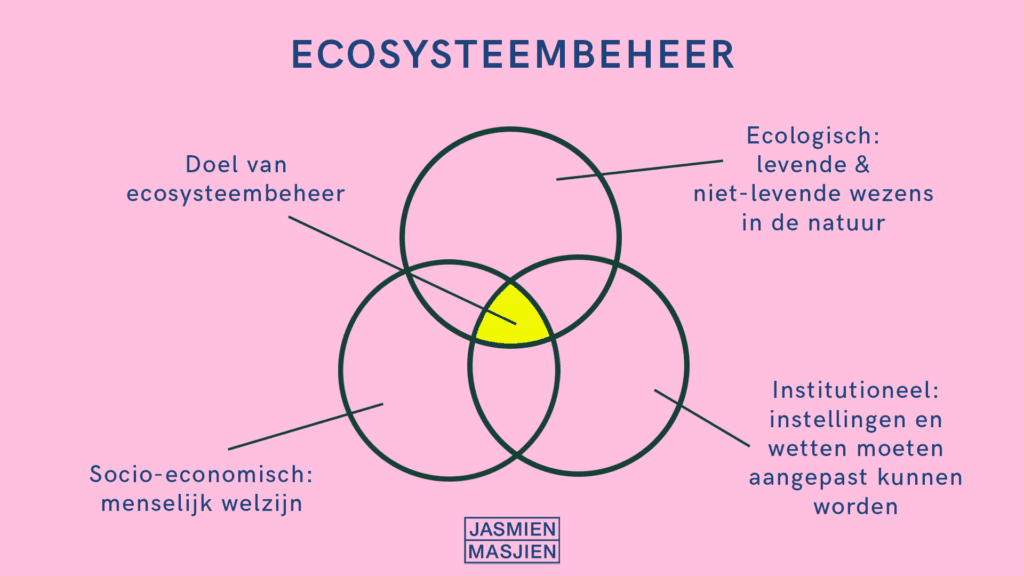Article by Jasmien for Fashion United: What do biodiversity and ecosystems have to do with fashion?
On ‘Sustainability Clarified’ – a series of Jasmien Wynants for Fashion United.
In this series, we take you into the wonderful world of environmental science. Each article clarifies a key topic related to ‘sustainability’. We zoom out to the bigger picture and then look in more detail at how these complex concepts are linked to the fashion industry.
This time, we talk about… biodiversity and ecosystems.
November 15, 2022, Fashion United
Ecosystems and ecosystem management
An ecosystem is a system that comprises all organisms within a given area, their interaction with each other and their interaction with the environment. Plants, animals and micro-organisms influence each other and together form a living community. It involves both ‘nature’ (forests, rivers, grasslands) and ‘culture’ (fields, plantations).
The latter systems are ‘managed’ by humans to optimise yields (food, fodder, timber). However, nature can also be managed, often with the overall aim of preserving (or restoring) biodiversity.
Is it about ‘nature management’ then?
There is an important difference between ‘nature management’ and ‘ecosystem management’. The latter explicitly looks at human benefit. After all, ecosystems perform a number of functions that are valuable, such as pollinating crops, absorbing CO2 from the atmosphere, etc. These are called ecosystem services.

Globally, we are seeing a decline in these ‘ecosystem services’. This has not only ecological consequences, but also an economic impact. To give an example: many tropical coastal areas (think of exotic destinations like Fiji, Aruba or Indonesia) are home to mangroves. These are coastal forests whose large, thick roots can often be seen protruding above the water. Mangroves are very important for biodiversity and carbon sequestration, but are highly threatened worldwide. If mangroves disappear around coastal areas, not only is it detrimental to biodiversity, but also the protection of that coast (and the people who live there) is threatened, as well as the income from tourism linked to these sights. There is a correlation between ecology, economy and human carrying capacity that we often give too little thought to.
Biodiversity loss
Biodiversity is the variety of life, in all forms on Earth. It is not just about the number of species, but also their genetic variation and the interactions these species have within complex ecosystems.
Earth’s biodiversity is declining. This is partly due to an ever-increasing ‘extinction rate’. Normally about 1 to 5 species die out per year, but scientists estimate that this rate is already 100 to 10,000 times higher. Beyond that, ‘biodiversity loss’ is more than mere species extinction, but also involves the decline of populations. This is largely due to human development. The huge growth in population has far-reaching and complex consequences (as you can also read in the piece on global warming), including impacts on freshwater, pressure on agriculture, flood risk, more diseases, more deaths from heat and climate refugees.
And why should we care?
The decline in biodiversity has a bigger impact than we sometimes think. A species lives in an ecosystem and affects it. Protecting tigers goes – to put it bluntly – far beyond ‘saving those beautiful critters’. Predators keep ‘prey animal’ populations down. If the predators disappear, herbivores are given free rein, and that too can have major consequences for an entire ecosystem.
Another example is deforestation. This not only leads to the disappearance of the panda and orang-utan, but has major consequences for nature and humans. The more trees we cut down, the more CO2 is released (especially from the forest floor) and the faster the earth warms up. The more natural areas are affected, the greater the risk of (new) viruses jumping from wild animals to humans. By reducing forests, humans and animals live closer together. In addition, we also come into contact with potential pathogens during logging, which would normally remain in a contained ecosystem.
The European Commission indicates that more than a football field of forest disappeared every second in 2017. Deforestation is most concentrated in tropical rainforests. These disappear at a rate of 13 million hectares a year. Or also: about the size of Greece.
Biodiversity loss thus plays a crucial role in all kinds of processes, including climate change, and is linked to many changes. Humans are the main cause of the rapid decline in biodiversity, but can therefore take action to change this.
Man inside or above an ecosystem?
When we talk about climate change, we are quick to say ‘we are doing it for the planet and nature’ or ‘we want to save the earth’. Understandable, as scientists estimate that 99.9 per cent of all species are already extinct (on a timescale of 3.5 billion years). However, what we often forget is that we humans are also just one species. Earth has existed for about 4.5 billion years. Humanity about 200,000.
Man’s impact on the environment and nature has increased exponentially over the past few decades. So curbing its impact, we are certainly not only doing it ‘for the planet’, but also (and maybe even mainly) for ourselves and those who come after us.
And can we talk about fashion now?
Unfortunately, the fashion industry also contributes to biodiversity loss.
Cotton is used in about 25 per cent of our clothes. We consume clothes like hotcakes. To maintain this rate, a huge area of land is needed to grow cotton. On top of that, cotton grows best in warm countries like China, India, the US and Brazil. Since cotton is a very thirsty crop, it often strains rivers and groundwater in those regions, leading to soil depletion and water shortages. One of the most famous examples is the parched Aral Sea on the border of Uzbekistan and Kazakhstan. The lake used to be one and a half times the size of the Netherlands. Today, all that remains is one big sandpit.
And to add to that, growing cotton requires a lot of chemicals that not only damage the soil, but also cause a lot of insects, birds, trees – entire ecosystems – to disappear or wither away.
There is one material that is used even more than cotton: polyester (62 per cent of our clothes contain polyester or some other similar oil-based material). When polyester clothes are washed, tiny micro-plastics are released every time. Those tiny particles flow with the water from our washing machine, through the sewage system and along rivers and lakes to the sea. Not surprisingly, this has a major effect on marine ecosystems.
Also during the production process (mostly during dyeing, bleaching, coating, post-treatment), very harmful substances often end up in the water streams around the production facilities. In the factories where our clothes are produced, wastewater is far from always properly treated before it is discharged. This will be discussed in more detail during the next contribution.
Perhaps a positive note?
The fashion industry is looking for ways to do better. Some of the initiatives that can have a positive impact on biodiversity include:
- Using regenerative farming techniques for natural materials.
- Sustainable forest management for fabrics such as viscose, bamboo and other fibres that use trees, grasses or plants (you may also recognise the most well-known label from paper bags: FSC)
- The search for systems to filter out microplastics when washing our clothes
- Initiatives that encourage us to buy less and wear our clothes longer so that there is less need for new raw materials.
.
We asked the scientist… Hans De Boeck, Global Change Ecologist at the University of Antwerp
“Biodiversity loss is closely linked to other ‘global changes’. Each of these global changes has negative impacts on biodiversity, either directly (think deforestation and overexploitation) or indirectly (through climate change, pollution, the encroachment of invasive species, etc.). Thus, when we address these global changes, we also ensure that biodiversity loss is reduced. So many of the measures the fashion industry can take to reduce its climate footprint, for instance through more sustainable use of materials, are also important for reducing pressure on diversity. In addition, work can be done to minimise harmful techniques and processes throughout the chain, from raw material (e.g. pesticides, water use) to end product (e.g. during dyeing and bleaching, transport) and afterwards (e.g. washing, recycling).
The biggest challenge, however, is ever-increasing clothing consumption. If the benefits of better production techniques, recycling, etc. are outweighed by simply producing more and more clothing, then obviously there is no progress. The danger here too (just as was noted in the article on climate change) is ‘greenwashing’ by (parts of) the fashion industry: taking marginal green steps to ease the conscience of consumers and thus sell more and more. The most ‘green’ clothing is still the one that should not be produced.”

